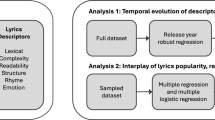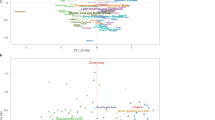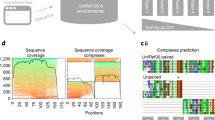Abstract
Complex networks have been studied extensively owing to their relevance to many real systems such as the world-wide web, the Internet, energy landscapes and biological and social networks1,2,3,4,5. A large number of real networks are referred to as ‘scale-free’ because they show a power-law distribution of the number of links per node1,6,7. However, it is widely believed that complex networks are not invariant or self-similar under a length-scale transformation. This conclusion originates from the ‘small-world’ property of these networks, which implies that the number of nodes increases exponentially with the ‘diameter’ of the network8,9,10,11, rather than the power-law relation expected for a self-similar structure. Here we analyse a variety of real complex networks and find that, on the contrary, they consist of self-repeating patterns on all length scales. This result is achieved by the application of a renormalization procedure that coarse-grains the system into boxes containing nodes within a given ‘size’. We identify a power-law relation between the number of boxes needed to cover the network and the size of the box, defining a finite self-similar exponent. These fundamental properties help to explain the scale-free nature of complex networks and suggest a common self-organization dynamics.
This is a preview of subscription content, access via your institution
Access options
Subscribe to this journal
Receive 51 print issues and online access
$199.00 per year
only $3.90 per issue
Buy this article
- Purchase on Springer Link
- Instant access to full article PDF
Prices may be subject to local taxes which are calculated during checkout



Similar content being viewed by others
References
Albert, R. & Barabási, A.-L. Statistical mechanics of complex networks. Rev. Mod. Phys. 74, 47–97 (2002)
Dorogovtsev, S. N. & Mendes, J. F. F. Evolution of Networks: From Biological Nets to the Internet and the WWW. (Oxford Univ. Press, Oxford, 2003)
Pastor-Satorras, R. & Vespignani, A. Evolution and Structure of the Internet: a Statistical Physics Approach (Cambridge Univ. Press, Cambridge, 2004)
Newman, M. E. J. The structure and function of complex networks. SIAM Rev. 45, 167–256 (2003)
Amaral, L. A. N. & Ottino, J. M. Complex networks—augmenting the framework for the study of complex systems. Eur. Phys. J. B 38, 147–162 (2004)
Albert, R., Jeong, H. & Barabási, A.-L. Diameter of the World Wide Web. Nature 401, 130–131 (1999)
Faloutsos, M., Faloutsos, P. & Faloutsos, C. On power-law relationships of the Internet topology. Comput. Commun. Rev. 29, 251–262 (1999)
Erdös, P. & Rényi, A. On the evolution of random graphs. Publ. Math. Inst. Hung. Acad. Sci. 5, 17–61 (1960)
Bollobás, B. Random Graphs (Academic, London, 1985)
Milgram, S. The small-world problem. Psychol. Today 2, 60–67 (1967)
Watts, D. J. & Strogatz, S. H. Collective dynamics of ‘small-world’ networks. Nature 393, 440–442 (1998)
Bunde, A. & Havlin, S. Fractals and Disordered Systems Ch. 2 (eds Bunde, A. & Havlin, S.) 2nd edn (Springer, Heidelberg, 1996)
Vicsek, T. Fractal Growth Phenomena 2nd edn, Part IV (World Scientific, Singapore, 1992)
Feder, J. Fractals (Plenum, New York, 1988)
Barabási, A.-L. & Albert, R. Emergence of scaling in random networks. Science 286, 509–512 (1999)
Xenarios, I. et al. DIP: the database of interacting proteins. Nucleic Acids Res. 28, 289–291 (2000)
Database of Interacting Proteins (DIP)http://dip.doe-mbi.ucla.edu (2000).
Jeong, H., Tombor, B., Albert, R., Oltvai, Z. N. & Barabási, A.-L. The large-scale organization of metabolic networks. Nature 407, 651–654 (2000)
Overbeek, R. et al. WIT: integrated system for high-throughput genome sequence analysis and metabolic reconstruction. Nucleic Acid Res. 28, 123–125 (2000)
Acknowledgements
We are grateful to J. Brujić for many discussions. This work is supported by the National Science Foundation, Materials Theory. S.H. thanks the Israel Science Foundation and ONR for support.
Author information
Authors and Affiliations
Corresponding author
Ethics declarations
Competing interests
The authors declare that they have no competing financial interests.
Supplementary information
Supplementary Information
Additional information relating to (a) the box covering method, (b) scale-free tree structure, (c) internet, (d) protein-protein interaction networks, (e) random scale-free networks, (f) the Barabasi-Albert model and the Erdos-Renyi random graph at criticality, and (g) cellular networks. The file contains Supplementary Figures 1-7, Supplementary Table 1 and Supplementary References. (PDF 2123 kb)
Rights and permissions
About this article
Cite this article
Song, C., Havlin, S. & Makse, H. Self-similarity of complex networks. Nature 433, 392–395 (2005). https://doi.org/10.1038/nature03248
Received:
Accepted:
Issue Date:
DOI: https://doi.org/10.1038/nature03248
This article is cited by
-
Predictive algorithm for the regional spread of coronavirus infection across the Russian Federation
BMC Medical Informatics and Decision Making (2023)
-
Laplacian renormalization group for heterogeneous networks
Nature Physics (2023)
-
A zoom lens for networks
Nature Physics (2023)
-
The nature and nurture of network evolution
Nature Communications (2023)
-
Reconstructing a fractal supply chain network based on geographical characteristics
Nonlinear Dynamics (2023)
Comments
By submitting a comment you agree to abide by our Terms and Community Guidelines. If you find something abusive or that does not comply with our terms or guidelines please flag it as inappropriate.



